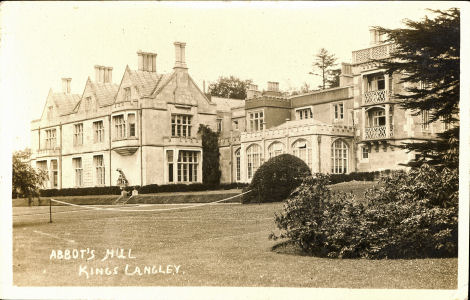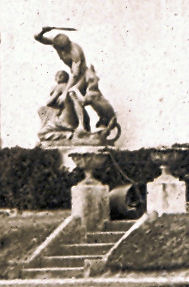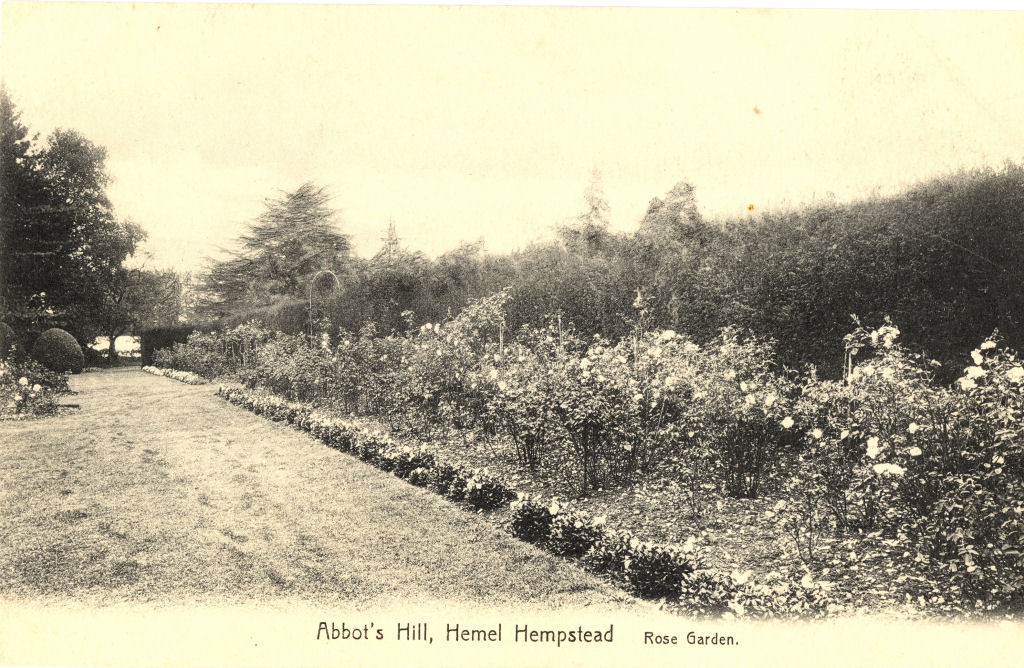|
Abbots Hill, Abbots Langley |
|
Abbots Hill, Abbots Langley |
 |
 |
Abbots Hill (from Abbots Langley, A Hertfordshire Village)
In 1809 John Dickinson (1782-1869) bought Apsley Mill and two years later he bought Nash Mills. Using these mills, near to the River Gade, he established what was destined to become a hugely successful international paper-making business. By 1837, a very prosperous John Dickinson was resident at Abbots Hill. This was a very fine house he had built for himself on the eastern side of the Gade valley. His chosen site was high on the spur of land previously occupied by Black Hill Farm. In the construction of this house, it has been written that his builders made good use of surplus building materials employed in the construction of the local stretch of the London to Birmingham railway. It is also said that John Dickinson had only one door built to the front of this substantial building, so that he could more easily scrutinise all visitors to his house. The Dickinson family lived very well. For example it is recorded, that in 1843, his daughter Harriet Ann hosted a total of thirty five balls at Abbots Hill. John Dickinson eventually handed over the running of his factories to his nephew, John Evans in 1851. It was John Evans (1823-1908) who married his daughter, Harriet Ann. John Evans was to develop an international reputation as an archaeologist, later becoming Sir John Evans. Harriet Ann, who died when she was 35, was the first of his three wives.
Sir John's eldest son, Arthur Evans (1851-1941) showed little interest in the Paper Mills. He was also an archaeologist of international repute, chiefly remembered for his discovery of the Minoan civilisation on Crete. His second son, Lewis Evans (1853-1930) did become a partner in the Company. Arthur Evans was the owner of Abots Hill when it was bought in 1912 by Katerine Baird and her sister Mary. The two Miss Bairds then founded a private fee-paying school for girls at Abbots Hill. The school continues to prosper to this day, under the direction of its current headmistress, Mrs J.S. Kingsley. Abbots Hill School is set in 70 acres of parkland and caters for 160 pupils, aged between 11-16. In 1968, an independent junior school, St Nicholas, moved here from Hemel Hempstead and this has a further 100 pupils aged 4-11.
There are many pictures of the house in A Hertfordshire Valley
 |
Abbot's Hill, Hemel Hempstead [sic] Rose Garden Publisher P. A. Buchanan & Co, Croydom, No 29674 |
The Telescope at Abbots Hill, Abbots Langley, 1860s
The Dacorum Heritage Trust Winter 2014 Newsletter has an interesting article suggesting that John Dickinson, of Abbots Hill, and Charles Dickens had an important mutual acquaintance in Sir Edward Bulmer-Lytton, of Knebworth House. It also brings together other evidence - and in particular a BBC interview Could this be the setting of Dickins' Bleak House? reveals some very relevant facts. So will this end the arguments over which house in Hertfordshire, supposedly near St Albans, was the model for the house described in the novel Bleak House?
| November 2010 | Page Created | |
| November 2011 | Rose Garden picture | |
| December 2014 | Bleak House reference |